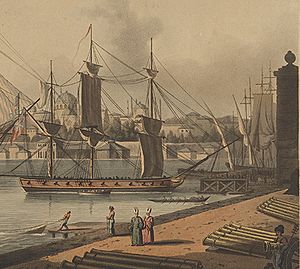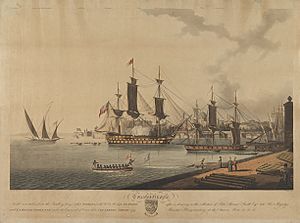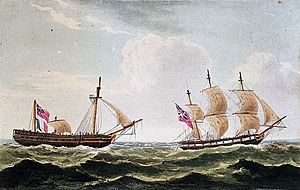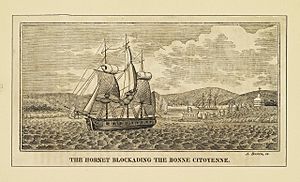HMS Bonne Citoyenne (1796) facts for kids
class="infobox " style="float: right; clear: right; width: 315px; border-spacing: 2px; text-align: left; font-size: 90%;"
| colspan="2" style="text-align: center; font-size: 90%; line-height: 1.5em;" | 
|} The Bonne Citoyenne was a 20-gun corvette (a type of small warship) built for the French Navy. She was launched in 1794. This ship was the first of her kind, meaning other ships were built based on her design. She sailed in the Bay of Biscay and the English Channel.
In 1796, the Royal Navy (Britain's navy) captured her. They renamed her HMS Bonne Citoyenne and used her as a sloop-of-war (another type of small warship).
The captured Furieuseis taken in tow to Halifax, Nova Scotiaby HMS Bonne Citoyenne. This is a print by Thomas Whitcombe.
Under British command, she served in the Mediterranean Sea. She even took part in the Battle of Cape St Vincent. She was taken out of service in 1803 but returned in 1808 after repairs. She then sailed in the Atlantic Ocean.
Her most famous moment was capturing the much larger French frigate Furieuse on 6 July 1809. Her crew received the Naval General Service Medal for this brave action. Later in her career, she served in South America. Her design was even used for other British ships. She was stored away in 1815 and sold in 1819.
Contents
| History | |
|---|---|
| Launched | 9 July 1794 |
| Captured | By the Royal Navy on 10 March 1796 |
| Name | Bonne Citoyenne |
| Acquired | by capture 10 March 1796 |
| Honours and awards |
|
| Fate | Sold on 3 February 1819 |
| General characteristics | |
| Class and type | Bonne Citoyenne-class corvette |
| Tons burthen | 5114⁄94 (bm) |
| Length |
|
| Beam | 30 ft 11 in (9.4 m) |
| Depth of hold | 8 ft 7 in (2.6 m) |
| Sail plan | Full-rigged ship |
| Complement |
|
| Armament |
|
French Service and Capture
The Bonne Citoyenne (which means 'good citizen' in French) was built and launched in 1794. She began active service in 1795. Her early missions were in the English Channel and the Bay of Biscay.
On 4 March 1796, she left Rochefort, France. She was part of a group of French ships heading to the Île de France. The Bonne Citoyenne was carrying soldiers and a lot of soldiers' clothing.
During this journey, the Bonne Citoyenne was damaged in a storm. She became separated from the other French ships. On 10 March, she met a British squadron led by HMS Phaeton. The British ships captured her about 58 leagues (about 174 miles) off Cape Finisterre, Spain.
The British then took her back to England as a "prize" (a captured enemy ship). She was officially added to the Royal Navy as HMS Bonne Citoyenne.
Two French prisoners from the Bonne Citoyenne tried to escape from a British prison. They were then put on a ship called the Lady Shore. This ship was taking them and other prisoners to Botany Bay in Australia. However, the French prisoners started a mutiny and took control of the ship. They sailed to Rio de Janeiro, where French ships rescued them.
British Service in the Mediterranean
The Bonne Citoyenne got her first British captain, Sir Charles Lindsay, in June 1796. In January 1797, she sailed to the Mediterranean Sea. There, she joined a group of British ships near Cadiz, Spain.
- In January 1797, the squadron captured two Spanish merchant ships, Santa Natalia and Caridad.
- In February, they captured two Spanish brigs (small ships), San Juan Baptista and Virgine de Monserrate. They also captured the Spanish ship San Francisco.
The Bonne Citoyenne was present at the Battle of Cape St Vincent on 14 February 1797. She was the ship that first spotted the French fleet. Her crew later shared in the "prize money" from the battle. This was money given to sailors from the sale of captured enemy ships. Years later, a special medal was given to those who fought in this battle.
After the battle, the British ships anchored in Lagos Bay. The Bonne Citoyenne was part of a group sent to find a huge Spanish ship called Santissima Trinidad. They found her, but for unknown reasons, the British ships stopped chasing her.
In March 1797, Captain Lord Mark Kerr took command, followed by Commander Richard Retalick in May. That summer, the Bonne Citoyenne captured several ships:
- Pleuvier, a French privateer (a private ship allowed to attack enemy ships).
- Canarde, another French privateer.
- Two Spanish brigs carrying money.
- A Spanish ship called Jengin del Rosario with soldiers on board.
- Eight other small Spanish merchant ships.
Commander Josiah Nisbet became captain in May 1798. In October, Bonne Citoyenne and Goliath captured two French ships off Sicily. One was carrying corn, and the other was carrying goods.
The Bonne Citoyenne joined Admiral Horatio Nelson's fleet in the Mediterranean. She arrived at Abu Qir Bay ten days after the famous Battle of the Nile. Nisbet was promoted in December.
In January 1799, Nelson ordered the Bonne Citoyenne to take the Turkish Ambassador to Constantinople. She then sailed to Malta to join the British ships blocking the French army there.
Commander Thomas Malling took over in August 1799, followed by Commander Robert Jackson in October.
The Bonne Citoyenne was part of the British fleet that blocked Malta for two years. She shared in the prize money from capturing several French warships and privateers during this time, including:
- The French warship Genereux (February 1800).
- The French warship Guillaume Tell (April 1800).
- The French privateers Redoubtable and Entreprenant (June 1800).
- The French frigate Dianne (August 1800).
On 5 September 1800, the British took control of Malta. The Bonne Citoyenne and her crew received prize money for this victory. She also shared in the capture of other ships, including a Ragusan ship and two Greek ships.
On 31 December 1800, Captain Jackson and the Bonne Citoyenne captured a Spanish privateer called Vives. This ship had ten guns and 80 crew members. Vives had recently captured a merchant ship, which the Bonne Citoyenne also recaptured.
The Bonne Citoyenne then returned to Gibraltar. She was part of the ships that captured Eurydice in February 1801.
Next, she sailed to Egypt with Lord Keith's fleet. They attacked the French forces at Alexandria. In June, Bonne Citoyenne and two other ships captured four French ships off Alexandria. After the Battle of Alexandria and the siege, the Bonne Citoyenne was among the British ships that entered the harbor on 21 August.
In 1850, a special medal called the Naval General Service Medal was given to crews who served in the Egypt campaign. The Bonne Citoyenne crew qualified for this medal.
Jackson was promoted in April 1802, and Captain Philip Carteret took command in May. The Bonne Citoyenne was taken out of service in 1803. She was repaired in 1808 and returned to service under John Thompson.
The Bonne Citoyenne Captures the Furieuse

In April 1809, William Mounsey became the captain of the Bonne Citoyenne. She returned to England and then sailed from Spithead on 18 June 1809. She was escorting a group of merchant ships (a convoy) to Quebec.
On 2 July, lookouts spotted a suspicious ship behind them. Captain Mounsey dropped back to investigate, losing sight of the convoy. As he tried to rejoin the convoy, on 5 July, he found a French frigate capturing an English merchant ship. Even though the French frigate was much bigger, Mounsey immediately chased it.
After an 18-hour chase, the Bonne Citoyenne caught up with the French ship on the morning of 6 July. A battle began. The fight lasted seven hours. The Bonne Citoyenne was at a disadvantage early on when three of her guns broke. However, she fired 129 broadsides (all guns on one side firing at once) compared to the enemy's 70.
By the end of the battle, the Bonne Citoyenne's masts were badly damaged, and her ropes and sails were torn apart. Running low on gunpowder, Mounsey decided to board the French ship. But before he could, the French ship surrendered.
The captured ship was the Furieuse. She was a large frigate, capable of carrying 48 guns. However, at the time, she only had 20 guns, but they were very powerful. She also had a much larger crew of 200 sailors and 40 soldiers. The Furieuse was heavily damaged, with five feet of water in her hull. She had lost 35 men killed and 37 wounded. The Bonne Citoyenne, by contrast, had only one man killed and five wounded. Mounsey believed their low losses were because his ship was lower in the water, making it harder for the enemy to hit.
The Furieuse was quickly repaired enough for the Bonne Citoyenne to tow her to Halifax, Nova Scotia. Both ships then underwent more repairs. The Royal Navy took the Furieuse into service, keeping her name. The Bonne Citoyenne returned to England in September.
This victory led to promotions for the officers. The Bonne Citoyenne's first lieutenant was promoted, and Captain Mounsey was also promoted. Mounsey received a special gold medal for his brave action. In 1847, another medal was given to all surviving sailors from the Bonne Citoyenne who fought in this battle.
Greene and the Americans
In 1810, Commander Richard James Lawrence O'Connor took command of the Bonne Citoyenne. On 21 June 1810, she captured a French privateer called Maitre de Danse in the Channel. O'Connor was promoted in October 1810.
In November, Pitt Burnaby Greene became captain. He was promoted in March 1811, and the Bonne Citoyenne was re-classed as a "post-ship" (a larger type of warship). Greene sailed her to South America. She was based at the River Plate.
When the War of 1812 started between Britain and the United States, Greene was carrying a large amount of money (about half a million pounds) from Rio de Janeiro. Unfortunately, the Bonne Citoyenne was damaged when she ran aground. She had to go to Salvador for repairs.
While she was in port, two American warships, the USS Constitution and USS Hornet, arrived. The captain of the Hornet challenged Greene to a one-on-one battle. The American Commodore (a senior officer) promised that his larger ship, the Constitution, would not interfere.
The Bonne Citoyenne and Hornet were quite evenly matched in terms of guns and crew size. Greene replied that he expected to win such a fight. However, he said he couldn't expect the American ships to ignore their duty and not help if the Bonne Citoyenne won. So, he politely refused the challenge at that time and place. He stated he would be ready to fight if the situation were different.
The Constitution left on 6 January 1813. But the Bonne Citoyenne still did not leave port, even though the Hornet seemed to be alone. The arrival of a larger British ship, Montagu, on 24 January 1813 finally forced the Hornet to leave. She sailed to the Caribbean. Greene sailed for Portsmouth on 26 January, arriving in April. The Bonne Citoyenne then returned to Jamaica before coming back to Britain.
Fate of the Ship
Around August 1814, Captain Augustus Clifford took command of the Bonne Citoyenne. She was put into "ordinary" (stored away) in January 1815. The Navy decided to sell her on 3 February 1819. She was sold to Joshua Crystall for £1,550.



